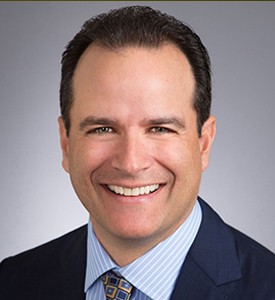
“It is important that the industry actively engages and educates policymakers on the positive impact and value that innovation brings to the health of our economy and the health of our nation. We need to protect entrepreneurship and bold biomedical innovation in California.”
RELATED PUBLICATION
ARTICLES FROM THIS PUBLICATION
Mike Guerra
PRESIDENT & CEO, CALIFORNIA LIFE SCIENCES ASSOCIATION (CLSA)
Could you outline your mandate for the California Life Sciences Association (CLSA)?
Building on our combined organization 40-year legacy, CLSA’s mandate is to continue working closely with industry, government, academia and others to shape public policy, improve access to innovative technologies and grow California’s life sciences economy. CLSA provides tools to ensure our state’s life sciences sector can grow and thrive. With offices in Sacramento, San Diego, South San Francisco, Los Angeles and Washington D.C., our mission to advocate, connect and innovate for the benefit of our entire California life sciences community will become even more important in the coming years as we focus on bringing more value to patients and communities throughout California.
We’re honored to be California’s life sciences trade association representing hundreds of life sciences organizations across the state that range from small organizations to large multinationals, spanning various applications of life sciences, such as health, industrial, environmental, food and agriculture, device companies, diagnostics, biotechs and pharmaceuticals.
I am privileged to lead CLSA and look forward to growing the association as we continue our statewide growth, as well as cultivate strong relationships with officials locally, in Sacramento and in Congress to ensure that California remains the global leader in life sciences research, economic investment and job creation.
From San Diego, Orange County and Los Angeles, to the Bay Area, how are you able to create synergy and share strengths amongst California’s life sciences hubs?
CLSA’s state-wide legacy spanning four decades has helped to cultivate strong connections between these key hubs by supporting the life sciences ecosystem through our premier business support and development activities, as well as our white glove public policy advocacy. We bring the life sciences sector together by providing hundreds of educational events and offering advising networks, and we also set up partnering meetings for large and small companies.
The tools we offer entrepreneurs and innovators help them to thrive and stretch their dollars so they can continue doing what they do best. CLSA members enjoy a wide range of benefits, such as group purchasing savings via our Power Purchasing Program. This allows discounted access to lab supplies, office supplies, premium medical, dental and vision health plans and more. CLSA’s work to foster strong regional synergy is further evidenced by our robust menu of opportunities for sources of capital and entrepreneurial support programs – all in addition to our federal, state and local advocacy.
The growth in the key life sciences clusters of San Diego, Orange County, Los Angeles and the Bay Area continues to exceed that of other regions around the nation due to our ecosystem approach and CLSA’s cultivation of it. The industry retains its strength because CLSA is constantly examining and evolving each piece of the ecosystem: education, infrastructure, corporate governance, investment, government regulation and other factors. CLSA plays a leading role in creating those synergies through our advocacy work, connection offerings and innovation services.
Drug pricing remains a hot topic in Washington D.C., especially as we enter the next presidential election cycle. What advocacy role is CLSA currently playing?
Nothing about life sciences innovation is easy, and new therapies and technologies do not come cheap. To go from concept to reality, they require sweat equity and major investment. Drug development is an arduous process that can take 20 years, sometimes longer, and costs north of US$2 billion. Policymakers must support, recognize and reward the value of drug discovery and life sciences innovation, and be on guard against ill-conceived, short-sighted proposals and policies that, in the name of “controlling prices,” could threaten patient care and undermine the promising research and investments into the miracle medicines and technologies of tomorrow.
CLSA will continue to be a trusted voice and partner with legislators in Congress and Sacramento, and our government relations teams look forward to working with them to advance meaningful proposals that will be helpful for reducing costs to the healthcare system, relieving financial burdens placed on patients, accelerating innovation and increasing access to innovative new therapies and technologies.
It is important that the industry actively engages and educates policymakers on the positive impact and value that innovation brings to the health of our economy and the health of our nation. We need to protect entrepreneurship and bold biomedical innovation in California. That’s why CLSA is leading the charge, and is laser-focused on helping policymakers not be deceived by proposals that may appear to cut costs in the short term, but could short-circuit the next generation of treatments and cures. We know it is possible to make medicines and high-quality care accessible and affordable for all patients, while preserving incentives for robust investment in R&D for new treatments and cures that are critically needed by tens of millions of people worldwide.
What will be the number one challenge facing California and the U.S. biopharmaceuticals industry in 2019?
To some, the California life sciences ecosystem may look like it is on autopilot, but we cannot lose sight of the factors that got us here. This success was hard won and even more difficult to maintain. We must continue to build a healthier business and regulatory and job-creation climate through smart public policy.
As strong as California’s life sciences ecosystem has become, we must always be aware of the growing communities in Europe, China and other regions that are also embracing biological innovation. Many Californians have worked hard to get the industry to the world-class innovation powerhouse it is today. CLSA is leading the way, ensuring that we maintain our leadership position on the world stage and being the center of innovation.
As the trade association representing the life sciences sector in California, CLSA takes this responsibility seriously, and we will continue doing what we do best: connecting the life sciences and cultivating strong relationships with policymakers locally, in Sacramento and in Congress to ensure that California continues to foster biomedical research, economic investment and job creation. By working together to improve public policy and providing life sciences innovators with the tools they need, we can accelerate the pace of innovation and help more patients.
What are CLSA’s key goals over the coming year, as well as your longer-term vision?
As we look to 2020 and beyond, one of the most important undertakings for CLSA and the broader life sciences sector will be to recognize and acknowledge that continued work needs to be done to ensure that patients have real access to the medicines, devices and diagnostics that are being developed in our state and elsewhere. No one should ever be denied the care they need.
It’s equally critical that policymakers understand the value of biomedical innovation and how it is moving the needle in patient care and improving our economy. California’s therapeutic pipeline – the process of taking a winning idea from concept to actual treatment – is long, expensive and fragile. Life sciences entrepreneurs often have great intellectual property but need investors to fund the nest phases of research needed to bring the idea forward. In turn, investors want to fund businesses they believe will be profitable. However, take away incentives or confidence and the pipeline falls apart. If innovators cannot recoup their investments, funders will migrate to tech or other sectors, leaving behind potential treatments for cancer, Alzheimer’s, diabetes and many other conditions. Ultimately, patients suffer.
That’s why it’s critical that we protect a healthy business climate and not demonize the people and companies who are doing the work and making the investments. Doing so risks short-circuiting the therapeutic pipeline, taking new treatments for cancer and other life-threatening conditions off the table.
Smart public policy plays a critical role in supporting a healthy business climate as well as encouraging improved access to diagnostic and therapeutic technologies and affordable care for all Californians. While California’s life sciences sector has done well, we face increasing competition from other states and nations.
As the trade association representing the innovative life sciences sector in California, CLSA believes it’s imperative to continue educating policymakers to help them understand both the positive and negative implications of their decisions and potential downstream effects of certain policies on the sector. CLSA is leading the way with our robust advocacy offerings, connection services and innovation advisers to keep California’s life sciences sector firing on all cylinders.











